파르보바이러스 B19 감염병 (전염성 홍반), Parvovirus B19 infection(Erythema infectiosum/Fifth disease)
전염성 홍반의 원인
-
전염성 홍반은 팔보바이러스 B19(파르보바이러스/Parvovirus B19) 감염으로 생기는 급성 바이러스 감염병의 일종이다.
-
전염성 홍반을 제 5병(The fifth disease)이라고 한다.
-
참고로, 다음과 같은 여섯 가지 발진성 감염병을 6병이라고 한다.
-
홍역은 제 1병,
-
성홍열은 제 2병,
-
풍진은 제 3병,
-
듀크병(Duke’s disease)은 제 4병,
-
전염성 홍반은 제 5병,
-
돌발성 발진(장미진)은 제 6병이다. 이 중 듀크병은 오늘 날 찾아보기 힘든 병이다.
-
전염성 홍반의 증상 징후
-
팔보바이러스 B19에 감염된 후 4~21일간 잠복기를 거쳐 약 15~30%에서 열, 피부 발진 등이 나타날 수 있다.
-
팔보바이러스 B19에 감염된 사람들의 기도의 분비물에 접촉되거나 혈액에 접촉될 때 감염될 수 있다.
-
임신부가 팔보바이러스 B19 바이러스에 감염 되면 태아도 그 바이러스에 감염될 수 있다. 특히 임신 첫 6개월 동안 태아가 팔보바이러스 B19 바이러스에 감염되면 태아수종이 생길 수 있고 그 중 약 2~6%에서 태아가 사망할 수 있다.
-
팔보바이러스 B19 바이러스는 세계적으로 퍼져있다.
-
사람 들에게 감염되면 증상 징후가 있을 수도 있고 아무 증상 징후가 없이 잠복 감염이 될 수 있다.
-
이 바이러스에 감염되어 전염성 홍반이 생길 때는 열, 근육통, 두통, 관절통, 관절염 등의 증상 징후가 나타날 수 있다.
-
뺨, 앞 목, 상부 앞가슴, 어깨, 양 위팔, 몸통, 엉덩이, 허벅다리, 손, 발 등 피부에 특이한 홍반(사진 3-62 ~ 3-69 참조)이 나타날 수 있다.
-
이 홍반은 1~3일간 계속 되다가 자연히 없어지는 것이 보통이다. 드물게는 이런 홍반이 몇 주 내지 몇 달간 계속 될 수 있다.
-
손바닥으로 뺨을 찰싹 맞은 후 바로 생길 수 있는 안면 홍반과 비슷한 짙은 홍반이 양 볼에 나타날 수 있고, 앞 목, 양쪽의 위팔의 바깥 부위에 레이스 장식 모양이나 그물 모양의 홍반이 나타나서 1~3주간 지속될 수 있다. 사진 3-62~69에서 볼 수 있는 것과 같이 이런 발진은 특이한 홍반이다.
-
때로는 드물게 미열, 두통, 복통, 콧물, 인두통 등 증상도 생길 수 있다.
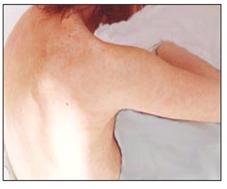
사진 3-62. 양 어깨와 팔의 바깥 면에 난 전염성 홍반 발진
Copyright ⓒ 2012 John Sangwon Lee, MD., FAAP
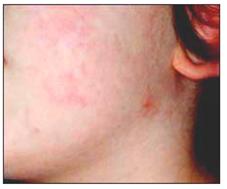
사진 3-63. 얼굴 뺨에 난 전염성 홍반 발진
Copyright ⓒ 2012 John Sangwon Lee, MD., FAAP
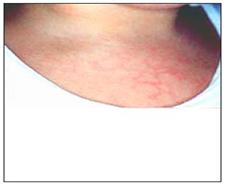
사진 3-64. 목에 난 전염성 홍반 발진
Copyright ⓒ 2012 John Sangwon Lee, MD., FAAP
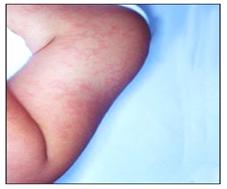
사진 3-65. 팔에 난 전염성 홍반 발진
Copyright ⓒ 2012 John Sangwon Lee, MD., FAAP

사진 3-66. 위와 아래팔에 난 전염성 홍반 발진
Copyright ⓒ 2011 John Sangwon Lee, MD., FAAP
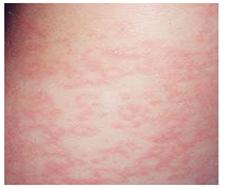
사진 3-67. 팔에 난 전염성 홍반 발진
Copyright ⓒ 2012 John Sangwon Lee, MD. FAAP
표 3-2. 팔보바이러스 19 감염병으로 생기는 병
| 팔보바이러스 19 감염의 종류 | 환자의 면역 상태 |
| 제 5병(전염성 홍반) | 면역 적격성이 있는 사람 |
| 다관절 병변 증후군 | 면역 적격성이 있는 사람 |
| 만성 빈혈/순 적혈구 형성 부전증 | 면역 타협성 상태에 있는 사람 |
| 일시적 형성부전증이 있는 경우 | 용혈성 빈혈이 있는 경우 |
| 선천성 태아 수증 / 선천성 빈혈 | 태아 |
| 지속성 빈혈 | 면역 타협성 상태에 있는 사람 |
참조문헌 Red book, 29th-31st edition
전염성 홍반의 진단
-
병력, 증상 징후와 진찰소견 등을 종합하여 진단하는 것이 보통이다.
-
드물게는 환자의 피에서 팔보바이러스 B19 IgM 항체검사, IgG 항체 검사, NAAT 검사, 팔보바이러스 B19 DNA, PCR 분석 검사등으로 확진한다.
-
약물 발진, 성홍열, 홍역, 풍진, 돌발성 발진 등의 감염병을 앓을 때 날 수 있는 피부 발진과 전염성 홍반으로 생긴 피부 발진을 감별 진단해야 한다.
-
이 병을 앓는 임신부의 태아에게 이 바이러스가 감염될 수 있다.
-
이 바이러스에 감염된 태아에게 심한 빈혈이 생길 수 있고 태아수종증도 생길 수 있고 태아가 사망까지 할 수 있다.
-
임신부가 이 병에 걸리거나 이 병을 앓는 사람과 접촉하거나 근접했을 때는 산부인과 전문의의 치료를 받아야 한다. [부모도 반의사가 되어야 한다–소아가정간호백과]-제17권 소아청소년 피부질환–피부 발진과 열이 나는 질병들 참조
전염성 홍반의 치료
-
이 병을 치료할 수 있는 특효약은 없다. 면역 글로불린 정맥 주사 치료에 효과가 있다. 그러나 대부분의 경우 대증 치료를 한다.
-
대개 자연히 낫는다.
-
예방접종 백신은 아직 없다.
-
잠복기는 4~21일.
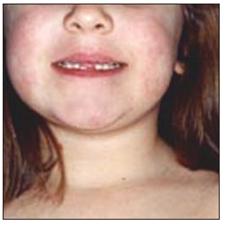
사진 3-68. 전염성 홍반의 발진으로 볼이 붉어져 있다.
Copyright ⓒ 2012 John Sangwon Lee, MD., FAAP

사진 3-69. 전염성 홍반의 발진으로 볼이 붉어져 있다.
Copyright ⓒ 2012 John Sangwon Lee, MD., FAAP
|
다음은 “얼굴, 양쪽 뺨이 맞은 것처럼 빨개요, 전염성 홍반”에 관한 인터넷 소아청소년 건강상담 질의응답의 예 입니다. |
Q.&A. 얼굴, 양쪽 뺨이 맞은 것처럼 빨개요, 전염성 홍반
Q.
안녕하세요?
저희 아이는 7살이구요.
이틀 전부터 양쪽 뺨이 붉게 달아오르며, 입 안쪽도 아프다고 합니다.
소아청소년에 갔더니, 바이러스에 의한 감염이라고만 얘기하더라구요.
미열도 같이 동반하여 아이의 얼굴이 마치, 사과처럼 보입니다.
왜, 이런 병균이 아이에게 생기는 건지…
평상시 어떡하면 예방할 수 있는지…
큰 병은 아닌지 궁금합니다.
A.
순님께, 안녕하세요. 질문해 주셔서 감사합니다. 좋은 질문입니다.
자녀의 나이, 성별, 과거 병력, 가족 병력, 진찰소견, 임상검사 결과 등의 정보를 많이 알수록 답변을 드리는데 도움이 됩니다. 주신 정보를 토대로 해서 답변을 드리겠습니다.
혹시 제5병(전염성 홍반)을 앓고 있는 것 같습니다.
더 자세한 내용은 전염성 홍반, [부모도 반의사가 되어야 한다–소아가정간호백과]-제17권 소아청소년 피부질환–전염성 홍반, 피부 발진(열꽃)과 열이 나는 질병들 등을 참조하시기 바랍니다.
그리고 질문이 더 있으면 다시 연락해 주시기 바랍니다. 감사합니다. 이상원 드림
Parvovirus B19 infection (Erythema infectiosum/Fifth disease)
Causes of Infectious Erythema
• Infectious erythema is a kind of acute viral infection caused by Parvovirus B19 (Parvovirus B19) infection.
• Erythema contagious is called the fifth disease.
• For reference, the following six infectious diseases are called six diseases.
o Measles is the first bottle,
o Scarlet fever is the second disease,
o Rubella is the third disease,
o Duke’s disease is 4th disease,
o Infectious erythema 5th disease,
o Sudden rash (rose rash) is the sixth disease. Among them, Duke’s disease is a rare disease today. Signs of symptoms of infectious erythema
• After being infected with palvovirus B19, after an incubation period of 4 to 21 days, fever and skin rashes may appear in about 15 to 30% of cases.
• People infected with palvovirus B19 can become infected when they come in contact with secretions from the airways or come into contact with blood.
• If a pregnant woman becomes infected with the falvovirus B19 virus, the fetus can also become infected with the virus. In particular, during the first 6 months of pregnancy, if a fetus is infected with the falvovirus B19 virus, hydrocephalus can occur, and about 2% to 6% of the fetus will die. • Falvovirus B19 virus is worldwide.
• When people are infected, they may have symptoms or have a latent infection with no symptoms.
• When infected with this virus and infectious erythema occurs, symptoms such as fever, muscle pain, headache, joint pain, and arthritis may appear.
• Unusual erythema (refer to photos 3-62 ~ 3-69) may appear on the skin on the cheeks, front neck, upper chest, shoulders, upper arms, torso, buttocks, thighs, hands, and feet.
• This erythema lasts for 1 to 3 days and usually goes away on its own. Rarely, this erythema can last for weeks or months.
• Dark erythema similar to facial erythema, which can occur immediately after slapped with the palm of the hand, may appear on both cheeks, and laced or reticulated erythema appears on the front neck and the outer part of the upper arms on both sides for 1 to 3 weeks. can last As shown in pictures 3-62-69, this rash is a characteristic erythema.
• Occasionally, symptoms such as low fever, headache, abdominal pain, runny nose, and sore throat may occur.

Picture 3-62. Infectious erythematous rash on the outer surface of both shoulders and arms Copyright ⓒ 2012 John Sangwon Lee, MD., FAAP

Picture 3-63. Infectious erythematous rash on the cheeks of the face Copyright ⓒ 2012 John Sangwon Lee, MD., FAAP

Picture 3-64. Infectious erythematous rash on the neck Copyright ⓒ 2012 John Sangwon Lee, MD., FAAP

Picture 3-65. Infectious erythematous rash on arm Copyright ⓒ 2012 John Sangwon Lee, MD., FAAP

Picture 3-66. Infectious erythematous rash on upper and lower arms Copyright ⓒ 2011 John Sangwon Lee, MD., FAAP

Picture 3-67. Infectious erythematous rash on arm Copyright ⓒ 2012 John Sangwon Lee, MD., FAAP
Table 3-2. A disease caused by palvovirus 19 infectious disease
| 팔보바이러스 19 감염의 종류 Types of Palvovirus 19 Infection | 환자의 면역 상태
the patient’s immune status |
| 제 5병(전염성 홍반) 5th disease (erythema contagious) | 면역 적격성이 있는 사람 immunocompetent person |
| 다관절 병변 증후군 polyarticular lesion syndrome | 면역 적격성이 있는 사람immunocompetent person |
| 만성 빈혈/순 적혈구 형성 부전증 Chronic anemia/naive erythropoiesis | 면역 타협성 상태에 있는 사람
people with immune compromise |
| 일시적 형성부전증이 있는 경우 If you have temporary hypoplasia | 용혈성 빈혈이 있는 경우If you have hemolytic anemia |
| 선천성 태아 수증 / 선천성 빈혈 Congenital fetal hydrocephalus / congenital anemia | 태아 fetus |
| 지속성 빈혈 persistent anemia | 면역 타협성 상태에 있는 사람
people with immune compromise |
Reference: Red book, 29th-31st edition
Diagnosis of infectious erythema
• It is common to make a diagnosis by combining medical history, symptoms, signs, and examination findings.
• Rarely, the patient’s blood is confirmed by falvovirus B19 IgM antibody test, IgG antibody test, NAAT test, falvovirus B19 DNA, PCR analysis, etc.
• Differential diagnosis should be made between a skin rash caused by infectious erythema and a skin rash that can occur when suffering from an infectious disease such as drug rash, scarlet fever, measles, rubella, and rash.
• The virus can infect the fetus of a pregnant woman with this disease.
• Fetuses infected with this virus can develop severe anemia, hydrocephalus and even death of the fetus.
• Pregnant women should seek medical attention from a gynecologist if they have this disease or come into contact with or come into contact with someone who has this disease. [Parents should also become anti-doctors-Children and Family Nursing Encyclopedia]-Volume 17 Skin Diseases in Children and Adolescents-Skin Rash and Fever Diseases
Treatment of Infectious Erythema
• There is no specific drug that can cure this disease. It is effective in the treatment of intravenous immunoglobulin injections. However, in most cases, treatment is symptomatic.
• It usually heals spontaneously.
• Vaccination There is no vaccine yet.
• The incubation period is 4 to 21 days.

Picture 3-68. The cheeks are red with a rash of contagious erythema. Copyright ⓒ 2012 John Sangwon Lee, MD., FAAP

Picture 3-69. The cheeks are red with a rash of contagious erythema. Copyright ⓒ 2012 John Sangwon Lee, MD., FAAP
The following is an example of a Q&A for health counseling for children and adolescents on the Internet regarding “face, red as if both cheeks were hit, erythema contagious”.
Q&A. face, red as if both cheeks were hit, erythema contagious
Q. Hello? Our child is 7 years old. Two days ago, both cheeks became red and the inside of the mouth was sore. When I went to children and adolescents, they only said it was an infection caused by a virus.
A mild fever also accompanies the child’s face and looks like an apple. Why do these germs develop in children? What can I do to prevent… I wonder if it’s a big bottle or not.
A. Hello, my dear. Thanks for asking. That’s a good question. The more information you know about your child’s age, gender, past medical history, family history, examination findings, and clinical test results, the more helpful it is to give you an answer. We will give you an answer based on the information you provided. You may have a fifth disease (erythema contagious). For more information, please refer to Infectious Erythema, [Parents Should Be At least half-Doctors – Encyclopedia of Pediatric and Family Nursing]-Volume 17 Skin Diseases in Children and Adolescents-Infectious Erythema, Skin Rash (Fever) and Fever Diseases, etc. And if you have any more questions, please feel free to contact me again. thank you. Lee Sang-won, M.D.
출처 및 참조 문헌 Sources and references
- NelsonTextbook of Pediatrics 22ND Ed
- The Harriet Lane Handbook 22ND Ed
- Growth and development of the children
- Red Book 32nd Ed 2021-2024
- Neonatal Resuscitation, American Academy Pediatrics
-
Neonatology Jeffrey J.Pomerance, C. Joan Richardson
-
Nelson Textbook of Pediatrics 14th-21st ed. Beherman,
-
The Johns Hopkins Hospital, The Harriet Lane Handbook, 18th edition
-
Red book 29-30th-31st edition
- Infectious disease of children, Saul Krugman, Samuel L Katz, Ann A. Gerhon, Catherine Wilfert
-
Childhood Emergencies in the Office, Hospital and Community, American Academy of Pediatrics
-
Emergency Medical Service for Children, By Ross Lab. May 1989. p.10
-
Emergency care, harvey grant and robert murray
-
Emergency Care Transportation of Sick and Injured American Academy of Orthopaedic Surgeons
-
Emergency Pediatrics A Guide to Ambulatory Care, Roger M. Barkin, Peter Rosen
-
Immediate care of the acutely ill and injured, Hugh E. Stephenson, Jr
-
The Critically Ill Child, Diagnosis and Management, Edited by Clement A. Smith
-
Emergency Medical Services for Children: The Role of the Primary Care Provider, America Academy of Pediatrics
-
The Harriet Lane Handbook 19th Edition
-
소아과학 대한교과서
-
제1권 소아청소년 응급의료 참조문헌과 출처
-
제2권 소아청소년 질병․안전사고 예방 참조문헌과 출처
-
제7권 소아청소년 감염병 참조 문헌 및 출처
-
Other
Copyright ⓒ 2014 John Sangwon Lee, MD., FAAP
“부모도 반의사가 되어야 한다”-내용은 여러분들의 의사로부터 얻은 정보와 진료를 대신할 수 없습니다.
“The information contained in this publication should not be used as a substitute for the medical care and advice of your doctor. There may be variations in treatment that your doctor may recommend based on individual facts and circumstances.
“Parental education is the best medicine.